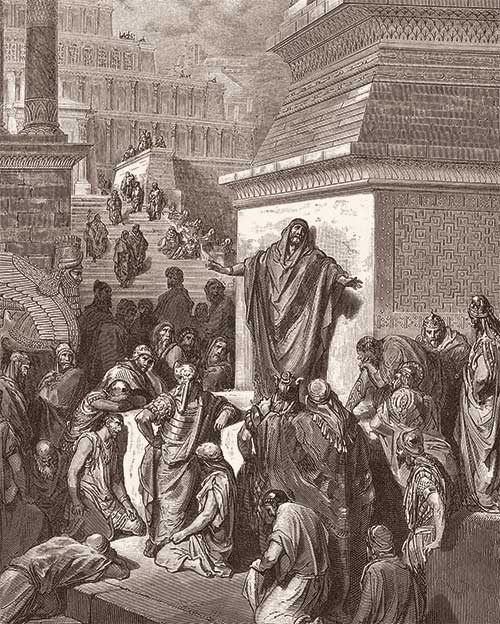“Repent, Repent”
In Leonard Cohen’s 1992 song “The Future,” a prophetic voice that introduces itself as “the little Jew / who wrote the Bible” proclaims imminent disaster: “I’ve seen the future, brother / it is murder.” In the song’s refrain, the voice repeatedly sings, “When they said, ‘repent, repent’ / I wonder what they meant.” But how could “the little Jew who wrote the Bible” fail to understand that—isn’t the Bible filled with calls for repentance?
In his new book, How Repentance Became Biblical: Judaism, Christianity, and the Interpretation of Scripture, David A. Lambert argues that repentance, as we understand it today, is, in fact, absent from the Hebrew Bible; it only emerged in the Second Temple period, in the broader context of Hellenistic philosophy. From that time on, repentance has been retroactively read into the scriptural texts through what Lambert calls a “penitential lens”—which feels natural to the post-biblical reader. Lambert aims to “denaturalize” the concept, while at the same time unearthing what scriptures really mean when they say—at least what they’ve been read as saying—“repent, repent.”
Repentance, in Lambert’s analysis, is a mental act, which occurs at a specific moment “within” the self and is often accompanied by sorrow. This implies that the self can successfully act upon itself: It reflects on its past from the distance of the present, feels regret, and decides to change. Repentance is thus part of a righteous life—an effort of self-reflection to identify and abandon unwanted behavior. But is this not what the biblical texts call for?
Not quite, Lambert argues. He begins by considering three practices frequently evoked in the Hebrew Bible, and commonly—but mistakenly—assumed to be expressions of repentance: fasting, prayer, and confession of sin. Lambert argues that the refusal to eat, far from being a penitential act in the Bible, simply makes distress physically manifest. Not unlike contemporary hunger strikes, biblical fasting is expressive: It compels the deity to pay attention and intervene. Hannah, for example, “would not eat” (1 Sam. 1:7): Her fast, just like her tears, embodies her affliction. Abstinence from food manifests her withdrawal from society; it also makes her prayer more forceful.
Prayer is often understood today as a form of introspection, likely to be accompanied by a penitential attitude. Lambert shows, however, that the first response to suffering, in the Bible, is an appeal to the deity. While we may wonder why God, if indeed omniscient, would need to be urged to act, many biblical texts portray a deity who needs to be notified of present injustice and reminded of past promises. Biblical prayer is first and foremost an act of communication; it conveys distress and urges divine intervention, without necessarily entailing a confession of sin. One of the most telling examples given by Lambert in this regard is Jonah’s prayer, for although it is clear that he is not blameless, his psalm mentions neither sin or regret.
This is not to say that the Bible contains no confessions of sin. For Lambert, however, biblical admissions of sin are not an expression of regret but rather a way to acknowledge someone’s power. Confessions usually occur in dialogue, not in a private inner speech—one confesses to someone. Those who confess in the Bible put themselves at the disposal of the offended party. For example, a closer look at Joseph’s story shows that he does not persuade his brothers to regret their actions; rather, he forces them to acknowledge his authority. When the brothers admit that “we are in a state of guilt on
account of our brother” (Gen. 42:21), there is no indication that they feel remorse. Rather, they surrender to Joseph’s power, as they make clear when they say, “We are your slaves” (Gen. 50:18).
Fasting, prayer, and confession, Lambert notes, all presuppose—and create—a power imbalance. These practices are not acts of repentance in our contemporary sense. They are not mental or inner acts, but occur within a relationship; they are not necessarily accompanied by an emotional state; finally, far from manifesting human agency and the capacity for change, these practices acknowledge the power of the being (human or divine) to whom they are addressed.
The phrase “returning [shuv] to God” has often been read as an expression of repentance. Indeed, the Hebrew word for repentance, appearing in mishnaic literature, is teshuvah, deriving from the verb shuv, which is sprinkled throughout the Bible. Lambert argues that the biblical shuv describes a radical—and physical—change of direction; however, it does not necessarily refer to a point of departure (as “return” does) or to the actual attainment of this point, and even less to an inner intention. The alleged “return to God,” therefore, cannot be understood as a purely mental act in which one reverts to a previous state. In the early prophets, shuv is frequently used alongside an appeal to the deity, as a recognition of one’s dependence on divine power. In later prophets, shuv comes to refer to the restoration of a relationship; it may also indicate a cessation of sin. In still later texts, such as Nehemiah, shuv is sometimes used to mean “turning back to God’s teachings.” This meaning is closer to our idea of “repentance,” though even here the verb describes something like a physical act, not an internal mental decision.
Lambert warns against the anachronistic identification of an appeal to inner transformation in biblical texts that, he argues, have little to do, in the end, with spiritual guidance. The prophets, he contends, have been too often misunderstood as moral teachers urging repentance, when they are closer to agents of the political establishment or the deity (or both). They are more concerned with justifying God than with the spiritual transformation of their audience. When prophets announce punishment, they do not employ it as an educational tool, but as a statement of the asymmetry in power between the transgressor and the ruler, human or divine.
In post-exilic literature, it is true, the cessation of sin is a way to avoid impending disaster, but, even here, not quite in the way in which one might expect. For example, in Ezekiel, the prophet urges the people: “Turn back, turn back from your evil ways, for why would you die, O House of Israel?” (Ezek. 33:11). The verse is explicit that God wants the people to survive. For Lambert, it is a way to make sure that the people—not the deity—are responsible for the fall of Jerusalem and the exile: “Your countrymen say ‘the way of the Lord is unfair’ but it is their way that is unfair!” (Ezek. 33:17). Such texts, therefore, seem less intent on urging their audience to transform than on reassuring it of divine justice.
According to Lambert, the reason for the absence of repentance in the Bible is that its notion of the human self is fundamentally different from ours. We think of ourselves as having an interior life, which can find expression in external acts. In this conception, fasting, for example, may be interpreted as an act designed to manifest a guilty conscience and demonstrate a desire to change. In biblical texts, by contrast, actions do not necessarily mirror inner states of mind. Fasting, for instance, is merely a strategy meant to reinforce a plea to a being who holds power over one’s life. Since we believe today that human beings can transform themselves through introspection, we tend to read the scriptures as a tool for self-improvement, but Lambert argues that most biblical texts focus rather on the deity’s power to change people.
This is thought-provoking, but has Lambert shown that the biblical self lacks interiority altogether? Or is it, rather, that mental life in the Bible is more unified, without our familiar split between “inside” and “outside”? Lambert makes a strong case that the biblical self cannot stand at a distance from itself, in the way in which Hellenistic and modern selves seem to in moments of self-reflection. And yet this is not to say that the Bible cannot conceive of some kind of transformation. More work needs to be done, by Lambert and others who will no doubt build on his work, to better understand the biblical sense of self and its potentialities.
Turning to Second Temple literature, Lambert argues that two movements that are sometimes called “penitential”—the Dead Sea sect and the Jesus movement—are still not entirely deserving of the title. In particular, the transformation of humankind that these texts frequently announce does not usually imply that human beings will change themselves. Thus, Jubilees, a rewriting of the book of Genesis associated with the Dead Sea sect, predicts a new creation of humankind at the end of time. The deity, just after the Flood (interpreted here as a precursor of the eschatological future), recreates human beings “so that they would not sin with their whole nature” (Jub. 5:12). The process, conspicuously, does not involve human decision, but only divine initiative. Likewise, the Rule of the Community, a key text organizing the life of the Qumran community, describes, in minute detail, initiation and purification rituals. These practices are sometimes interpreted as a manifestation of the inner change that the members of the sect are supposed to experience, but Lambert is skeptical. He argues that the purification actually entails an eschatological recreation, performed by the deity. The depiction of ritual immersion, for example, hardly requires the sectarian member to have any intent. Rather, the waters—through divine power—are operative: They “atone for his sin” (1QS 3, 6–7) and “purify his flesh” (3:8). What we find here is not an exhortation to change, but a community situating itself at the very beginning of eschatological times.
A similar argument can be made for some New Testament texts. John the Baptist, for instance, is often thought to preach repentance (metanoia) as inner transformation; however, at least in the Gospels according to Matthew and Mark, his call is better understood in eschatological terms, as an affirmation that the future foretold by the prophets has arrived. Metanoia is thus a consequence of the baptism, not a precondition. In these two gospels, calls for repentance are rare in Jesus’s proclamations. When sinners are called, it is Jesus who effects the change, not the sinners. These texts envision a global—even cosmic—transformation. Likewise, Paul often announces a re-creation of humankind, again to be performed by the figure of Christ. As hard as it may be for modern readers to understand, redemption is mostly presented as a passive event for human beings—something to be received, not performed.
Nonetheless, according to Lambert, it is in this period that something like our concept of repentance begins to emerge. The nascent notion is expressed by the terms we have already seen: metanoia (Greek), paenitentia (Latin), and teshuvah (Hebrew), all newly understood as describing a spiritual exercise (or, in Foucault’s terms, a “technology of the self”). They all presuppose a Hellenistic notion of self, capable of introspection and self-rule. In particular, metanoia begins to connote a painful self-reflection in which the sinner regrets his or her past. While the Stoics denigrate metanoia as unfitting for the sage, Middle-Platonist philosophers, in particular Plutarch, value metanoia as a method of self-improvement. Philo, the Jewish philosopher of Alexandria, sometimes identifies metanoia as a virtue, but not only to be practiced by the sage. Philo uses the Hellenistic motif of “conversion to philosophy” to express conversion from sinfulness to righteousness and from idolatry to Judaism.

The same idea is found in both popular and wisdom literature. Repentance plays a central role, for example, in Joseph and Aseneth, a Jewish novel composed in Greek, probably in Egypt around the 1st century C.E. Through repentance, Aseneth, the daughter of an Egyptian priest, transforms herself and becomes an acceptable bride for Joseph, Jacob’s son. Repentance is here embodied in a transcendent figure, who intercedes on behalf of Aseneth and all who repent (15:7). A century or two later, Testaments of the Twelve Patriarchs presents Jacob’s sons as moral exemplars. Repentance is here rooted in self-reflection; according to the Testament of Reuben, it is a choice of the soul (1:9). This use of patriarchal figures anchors repentance in the Bible, giving legitimacy to the new practice. Here, as elsewhere, repentance is literally read into the scriptures.
Rabbinic Judaism institutionalizes repentance, or teshuvah, as a mental practice at the core of a righteous life. It is associated with the Day of Atonement, as well as, according to one passage in the Tosefta, with sacrifice. By associating teshuvah with these ritual practices, Lambert notes, the rabbis reconcile the physical actions required by biblical texts to a growing concern with internal processes, such as intention and remorse. A midrash transmitted by the Pesikta de Rab Kahana betrays an awareness that something new is underway. The three parts of the biblical canon are personified as figures—Wisdom, Prophecy, and Torah. They are each asked about the fate of sinners and answer by invoking misfortune, death, and atonement through guilt-offering, respectively. The same question is finally addressed to God, who answers: “The sinner should repent and be forgiven” (Pesikta de Rab Kahana 24:7). Repentance, this midrash suggests, is not found in any of the three parts of the Bible, which have other ways to deal with sin.
Some rabbinic texts reflect a tension between the ideal of a lifelong practice of repentance (as a ba’al teshuvah or penitent) and a brief moment of repentance at death, as urged for example in Pirkei Avot, “Repent one day before your death” (2:10). This tension shows that repentance is available to all of Israel, both righteous and sinners, in keeping with the inclusive ethos of rabbinic Judaism. This concept of repentance is also found in the Gospel of Luke and the book of the Acts of the Apostles, where Jesus, Peter, and Paul are presented as “preachers of repentance” who urge new members of the movement to abandon their past lives and embrace a new identity through an internal choice. Both in rabbinic literature and in part of the New Testament, therefore, repentance functions as an instrument of both autonomy and control: The self internalizes its identity and rules itself in conformity with the demands of the community.
To return to Leonard Cohen’s song, repentance gains its meaning within systems of power where it functions not only as a promise of redemption, but also as a mechanism of control over our most intimate experiences. (“The blizzard of the world . . . has overturned / the order of the soul,” Cohen wrote. “Your private life will suddenly explode.”) As David Lambert shows, the act of repentance creates a rift inside the self, alienating it from its own past and creating a new identity—but this, Lambert argues in his provocative book, was not quite the message of the prophets, those “little Jews” who wrote the Bible.
Comments
You must log in to comment Log In
Suggested Reading
The Medieval Blueprint: A Rejoinder
Alexander Kaye understates the extent to which medieval Judaism gave rise to the idea of a halakhic state.

At the Anti-Israel Carnival
Students at Rutgers University protest Israel like they're attending a carnival. A professor explores the troubling scenes she's witnessed—and rereads Mikhail Bakhtin.

Ruthless Cosmopolitans
Susan Sontag kept saying hello to George Steiner, louder and louder, as he stared out the bus window refusing to answer. More or less standard behavior for both of them . . .
Re-Intoxicated by God
The way out is clearly marked: Intense Talmud study leads to intense study of science and philosophy. Spinoza was (in fact, sometimes still is) a crucial step along the path out.

jmdeteresa
The article is extremely interesting. I am intrigued by the notion of 'metanoia', which seems to be more general than strict (contemporary) repentance. This suggests that metanoia might have different sources, another one might be the duty to exert pardon as in the Christian Lord's prayer, or to love your neighbor, as in the Commandments.
But perhaps I am entirely wrong.